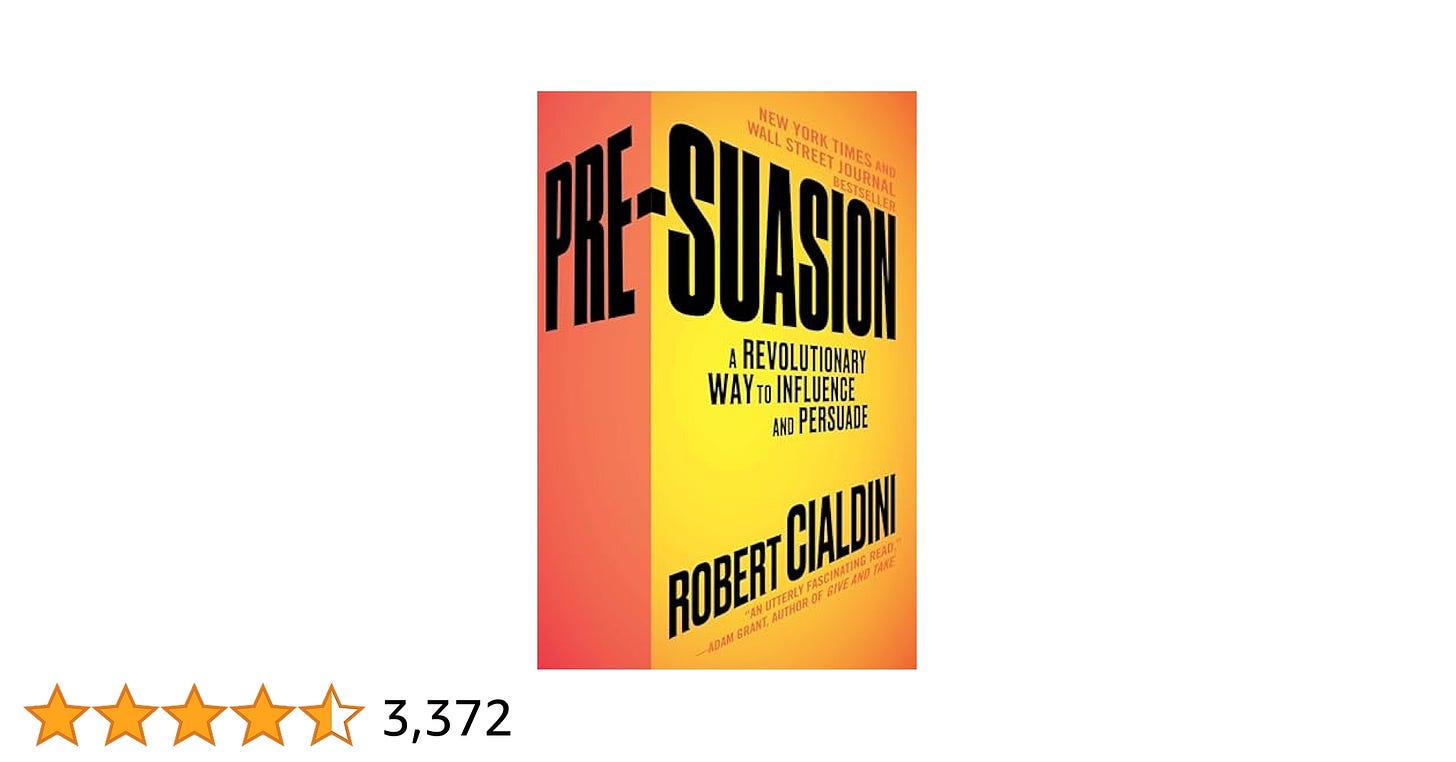Hi there and welcome back 👋🏻
I just got back from Cabo, where I spoke to a group of ~30 business owners at a beachfront resort.
On Monday night, I also went on a date conducted entirely through Google Translate—complete with salsa dancing. She didn’t speak a word of English, and my Spanish stops at muy bien. 😂 It was every bit as ridiculous and funny as you’d imagine.
But that’s a story for another time.
What felt surreal was this:
Someone paid thousands to fly me to Mexico, put me up at an all-inclusive resort, and have me speak at her event. A few years ago, that would’ve been unthinkable.
So I wanted to write this post about how you can overcome the fear of public speaking and get some of those benefits too.
Warning: This isn’t coming from an “expert” pedestal. I’m still learning.
But these ideas would’ve saved me considerable trouble if I had discovered them years ago.
What You’ll Learn
Here’s a breakdown:
How to win the inner game of speaking
How to improve your delivery with proven mastery tools
How to shift audience perception using psychology and structure
Part 1: Win the Inner Game
I used to have terrible stage fright.
Most people know me as fairly outgoing and confident. But I always felt like a fraud. Because when I had to speak publicly, I froze.
My throat would choke, my palms would sweat and I’d spiral into my head. And as they say in the military: if you are in your head, you’re dead. 😂
So I decided to fix it through exposure therapy.
I’ve now
spoken at 10+ high schools in Germany,
presented to family offices with over $100mm in net worth,
and just got back from Cabo where my entire trip was paid for.
So what made the difference?
Before the last event, I invested 2k to train with Eli Wilde, Tony Robbins’ #1 sales guy of all time. That weekend changed a lot for me.
So I’ll share with you what I do differently now.
And if can go from bumbling and blushing to having a serious impact on people’s business with a 45 minute talk, you can too.
Here’s how to win the inner game:
1) Purity of Intent
This is one of the most important things I learned from Eli.
What’s most people’s intention before the speak publicly?
“Don’t blow it”
But if your goal is to “not blow it” that’s a pretty lame baseline.
And there is even a school of thought in Neuro-Linguistic Programing (NLP) that the subconscious mind cannot differentiate negation from positives.
What does that mean for you?
To understand don’t blow it your brain must first fixate on blow it. And what we hold in mind tends to manifest in reality. This point has many applications otherwise but I’m sure you can already see that.
Now what’s the proper intention?
It depends on your goal.
Are you trying to sell? Influence? Help? All I wanted to do in Cabo was to provide as much value as possible. Simply to help them.
You can see how that completely changes your energetic state.
First of all you, if you focus your intention on the audience and their needs, you can see how that will change your internal decision tree.
But also, it gets you out of your head and away from validation seeking behavior. And everyone who’s ever been on a date knows that validation seeking behavior kills your perceived value.
It’s more helpful to focus on the audience, not yourself.
How this helps with “stage freight”
Secondly, in those moments when your heart rate starts pumping and your inner voice is racing, you can rest back in your intention of “helping them” and assuming you have the expertise to actually help, you will calm down again.
That leads to the second improvement:
2) Topic Determines Performance
When I gave the talk on AI to family offices, I would say it was a 3 or 4 out of 10. Not because I didn’t put a lot of effort into it… I was up at 4am stressing over my slide deck!
But because I’m not really an expert or obsessed with AI.
Instead though, when I present about sales, people always tell me it changed their life. Because I am obsessed with sales, have invested thousands of dollars and hours into mastering it and have mountains of evidence to prove I am an competent. (millions of dollars sold and success with different products).
You need topic-market fit.
Where you are an expert and the people listening need the information.
Again, I’m sure you can see how this makes things much easier. No need to be an imposter!
3) Influencing Your Own State
When I went to Eli’s house, he had a trampoline next to his desk.
I thought that was weird but then I asked him why. If you’ve never heard of state management, this one concept alone would’ve made me tens of thousands more in my first few years as a sales rep.
In short, your emotional state dictates how you show up in the world.
And the fastest way to shift your state is through movement.
Before every sales call now, I just bounce in place for 60 seconds. It clears whatever energy I was holding onto and puts me in a more present, powerful state.
Persuasion is a transference of state and you can’t give what you don’t have.
Remember to move before you speak.
PART 2: How to Improve Your Delivery
Now here’s how to actually improve your skillset:
1) Feedback and modeling (the easiest ways to learn quickly)
You need to relisten to yourself speak.
I’ve listened to 100s of hours of my own sales calls and sales presentations, mostly under professional guidance.
One surprising feedback I get?
My tonality is incredibly calming – but almost too calming and borderline psychotherapist like which puts me at a disadvantage in sales and maintaining attention.
And I never would’ve known that if I hadn’t reviewed the tape.
Eli told us that after every event, Tony would go home and literally handcopy the entire transcript of his speech just to make one or two word changes for the next time.
And so you need to be listening to yourself and asking for feedback from people who listened to you speak–ideally from an expert.
How to ask for feedback (without getting fake praise):
Most people ask:
“Do you have any feedback?”
That’s a mistake. Unless you totally bombed, the default answer will be:
“No, it was great!”
Instead, ask:
“What feedback do you have?”
This is an NLP trick. That one word shift triggers the brain to scan for specifics and that’s how you get actual data.
The power of modeling to turn decades into days
I learned this from language learning.
The reason I got so good so quickly at German and Chinese is because I used to listen to hours of podcasts per day and simply mirror (or model) the native speaker.
I even heard Leila Hormozi claim that a famous management consulting firm or Harvard Business like entity did a study that showed modeling is one of the two most proven ways to learn quickly.
So here’s what I suggest:
Find someone who’s great
Put on headphones
Go for a walk
And mirror their speech out loud
Right now, my favorite person to model is Eli Wilde.
But you can pick anyone from Tony Robbins, to Obama to Oprah.
It really doesn’t matter as long as you like their energy. But I promise you modeling will force their patterns of their persuasion to seep deep into your brain.
PART 3: Influencing the Audience
Now here are some actual psychological tactics to do a better job in the moment.
1) The power of pre-frames:
When I paid Eli $2k to spend a weekend at his house learning how to speak, he walked us through the exact principles he learned from two decades of working along side Tony Robbins–including some private lessons Tony taught him at his $50mm Island in Fiji.
One of the most valuable lessons he shared is that:
Your context determines the perceived value of your content.
Just think about how I pre-framed that sentence above:
Eli’s authority
My 2,000 investment
His 2 decade time investment
Tony Robbin’s private mentorship
You can see how that completely changes the perceived value of the next sentence. It tells your brain:
Pay attention, this is important.
That’s the power of a pre-frame.
Tony Robbins was a long time student of NLP, and this is where the idea originates.
Even Dr. Robert Cialdini, probably the worlds most respected persuasion expert, wrote an entire book about it called Pre-Suasion.
On his private Island, Tony told Eli that your pre-frame is the second most important part of communication, right behind connection.
How to Pre-frame Effectively:
Questions
“Why are some people confident speakers while most people are terrified?”
Cite Social proof (general)
*trump voice* People are telling me…
People keep asking me…
Use Authority:
Mother Theresa couldn’t beat those charges 😂
Tell a relatable story
Show’s “Ive been where you are” and makes people root for you.
Redefine the topic
Sales is not about X, it’s about Y.
Identity based preframes
Just being in this room means you’re the type of person who…
Metaphors and analogies
It’s kinda like how …
If you take nothing else from this post, remember the power of preframes.
2) Define the terms up front
This is a big one.
We kinda talked about it in the pre-frame section but it’s so important it deserves it’s own bullet point.
Here’s why:
If your audience defines the key terms before you do, they’ll interpret everything you say through their own filter—and if that filter is hostile, you’ve already lost.
Sales and blue hair
Imagine you’re giving a speech about sales to a bunch of blue haired liberals who hate capitalism.
What’s gonna happen?
They won’t hear your insights. They’ll compartmentalize you and everything you say into their “capitalism is evil” frame.
Instead you can preemptively strike and redefine or reframe sales from the jump:
A lot of people think sales is evil or a manipulative and I used to believe that too. Until I met my first mentor who sat me down and said Connor sales is not about pushing products on people who don’t need them. Sales is about helping people solve their problems.
You’re facilitating change for someone who otherwise can’t do it on their own.
Sales is service.
Can you see how that could open a sense of doubt and receptiveness to even the most blue haired audience? 😂
Quick takeaway:
If you don’t define the terms, the audience will define you, and potentially not kindly.
2) Personalization & Specificity
In marketing, people often say,
“If you speak to everyone, you speak to no one.”
And in one of Alex Hormozi’s original free courses, he once explained how personalization doesn’t just improve messaging, it increases perceived value.
Here’s how he broke it down (more or less):
Time management course: $21
Time management for sales: $49
Time management for Outbound B2B sales: $179
As you can see, same foundational content. But the more specific the audience, the more valuable the message becomes.
When I went to Cabo, I didn’t give a generic talk on “sales.” I tailored it specifically to the audience (Functional Medicine Practitioners).
Here is my beautifully AI generated intro slide:
Generic messages sound like background noise.
Specific messages feel like this was made for me.
4) Pay Attention Sentences
I learned this from a trail lawyer on YouTube.
Pay attention sentences are a mini-preframe. You explicitly tell people, this is important, listen:
The simple truth is…
I would write this down…
Listen, the thing is …
You don’t want to over use these but I would bet if you’re reading this, most people are so far on the unconfident spectrum that it would really improve your speaking to use sparingly.
5) Mind reader questions
This is a tactic from hypnosis.
Mind reader questions create a sense of psychological alignment. They show the audience you’re already inside their head, which builds instant trust.
Since Tony Robbin’s number one rule of communication is to connect with the audience, this is important.
So what does this look like?
You might say:
Now you might be thinking won’t that come across as cheesy?
Now you might be wondering, isn’t sales this evil thing for barbed-wired tattooed men in the sketchy car lot?
When you hit it right, it gives people a little boost of dopamine towards you and that builds rapport.
Best to do this especially when someone is likely forming an objection in their head.
6) Lead with an insight
A lot of people assume they should start with their story.
It’s safe. It feels human. But it’s often not the most effective way to grab attention.
If you want to build instant trust, curiosity and status, lead with something that surprises them–an insight they didn’t see coming.
This is how I started my presentation in Cabo:
Then I shared a bit about my credibility and we dove right into the idea of frames and how they either propel you forward or hold you back.
So why start there?
Because within 30 seconds, I had already demonstrated that:
I understood how they think
I could name the invisible force holding them back
And I had a lens that could help them break through it
That created instant buy-in, and it pre-framed the entire talk with competence.
Quick takeaway:
Don’t start with your story. Start by showing them you understand theirs, and where it’s falling short.
7) Pain Pleasure Principle
This is Human Psychology 101.
People move away from pain and towards pleasure.
This really dictates everything and Tony Robbins has been shouting from the rooftops about this for 30 years. And he’s right.
If your talk doesn’t clearly help people:
Escape something painful (confusion, fear, failure)
Or move toward something desirable (clarity, success, confidence)
… then they have no reason to pay attention
Quick takeaway:
Frame your message as a bridge: from pain to pleasure, and they’ll listen more intently.
Conclusion
There is so much more I’d like to add. But this is getting fairly long so we’ll stop here.
If you found this helpful and if you would like to hear more of the things I recently discovered around public speaking and persuasion leave a comment and happy to reply.
Let me know if this resonated and thanks for reading.













This is awesome!
I really enjoyed reading about your insights and I am enamored with your desire to constantly learn more and do better!❤️ Keep up the good work for yourself and all of us!😊